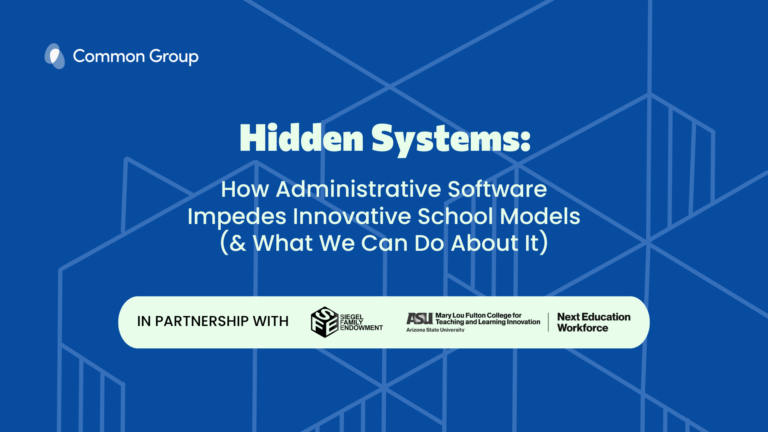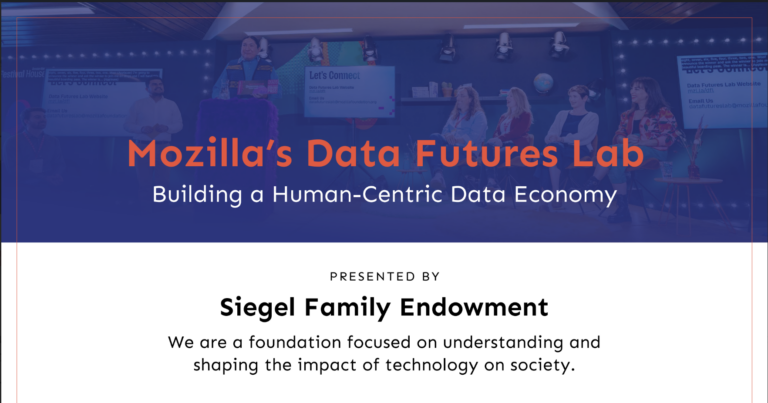How Jobs for the Future’s Financing the Future initiative is Conducting Research and Aligning Incentives to Reimagine How We Finance Postsecondary Education
Income sharing agreements (ISAs) and other income-contingent funding models for postsecondary education and skills development have made plenty of headlines over the last few years in ways good and bad. We believe they have the potential to be a viable financing mechanism for learners to achieve new skills while mitigating the uncertainty and risks associated with traditional loans. But exactly which models are most effective in reducing risk for students? Under what conditions do those models work best? What safeguards need to be in place to protect consumers? These are just some of the questions that Jobs for the Future’s (JFF) Financing the Future initiative explores every day.
Ahead of JFF’s annual Horizons conference, we sat down with Ethan Pollack, senior director of the Financing the Future initiative to understand the promise and pitfalls of income-contingent funding models, how providers can move to more student-centered models, and why stakeholders might not be as far apart as we might think. Along the way, Ethan explains why income sharing agreements are a bit like a hammer, how financing incentives can promote education quality, and why it’s important to talk to students about their experiences.
You head the Financing the Future initiative at Jobs for the Future (JFF). Why did JFF decide to launch Financing the Future? What are you hoping to accomplish?
Financing the Future was launched in 2020, with a goal of trying to rethink how we, as a society, pay for post-secondary education training. We are trying to encourage responsible experimentation in new models of paying for education. We hope that one or more of these models ends up becoming transformative, and it becomes a model around which we can design a new and better post-secondary education system. The two things that we look for in models are (1) incentive alignment and (2) shifting the risk away from the student.
Many of those models shift either the cost or risk onto the service provider (e.g. the school), which can align that organization’s incentives with its students’ economic outcomes. We see this incentive alignment as a way to bring a greater level of accountability to the market. Vigorous regulatory oversight remains extremely important, of course. But if the financing mechanism itself is able to ensure that schools are only getting paid if their students are succeeding, that can hard-wire accountability into the model itself.
We are also trying to shift the cost or risk away from the student. Education is a very expensive and risky investment for students. It makes sense to de-risk that investment as much as possible.
What’s your approach for examining different models that aim to address these two goals of achieving incentives alignment and shifting risk away from the student?
We view these models as seeds that are being planted, and our role is to give them a proper ecosystem where they can grow and thrive. We want to ensure that the soil is fertilized, that there’s sufficient sunlight and water, etc. We do this by conducting and facilitating rigorous research to better identify what’s working and what’s not working, and disseminating that knowledge into best practices. We also work to create regulatory guardrails to ensure that these approaches are done in a responsible way that is student- and equity-centered.
What do these approaches look like in practice? What types of materials are you producing to achieve your goals?
I’ll give you a few examples. First, we were able to leverage internal data from an ISA servicer, looking at contract terms and repayment patterns across the 51 different schools, to better understand the racial and gender equity implications of the ISAs. We published that research report last spring.
Second, we’ve also worked with other companies that have their own data and helped them think through what types of analysis they should do. We have a sense of where the knowledge base is and where it needs to go, so we can help move research in that direction.
Third, we also do a lot of work on best practices that are student-centered. We develop conceptual frameworks for what a student-centered approach should look like, highlight promising student-centered approaches, and offer guidance to providers on how to operationalize those approaches.
Finally, we work on policy at both the federal and state levels, which play an important role in ensuring that consumers are protected. We believe that policy, especially regulatory guardrails, can be a powerful tool to drive experimentation or piloting that is responsible. In particular, we need to be very intentional in how we design these regulations to ensure they are taking into account the unique structures of these financing approaches.
You’re interested in a range of financing models, including income share agreements (ISAs), social impact bonds, training accounts, employer incentives, and employment-based training models. What is it about these tools that you find promising?
It’s a combination of things. First, they fit the criteria of incentive alignment and moving risk away from the student. Second, they have the potential to be much more affordable for students, either because they are free to the student or because the payments are contingent on income.
And third, these are models that we already see emerging in the private market. It’s really hard to sell an idea that no one has ever heard of and that no one has done before. We’re not trying to invent things out of whole cloth. We are looking at what people are already starting to experiment with, and taking it from there. These are all models that exist to some degree or another already. We see our role as guiding their development and making sure that they’re done in a responsible way.
The list of possible financing models isn’t exclusive. In fact, we’ve had to redefine how we categorize these different models a few times over the last few years. For example, we used to call out ISAs as a specific model. But there has been a shift in energy towards outcomes-based loans, which operate very similarly to ISAs. I have shifted some of my language to instead refer to this category of approaches as “income contingent financing” because I don’t want to make it seem like these things are massively different from each other. There are some differences, but there’s enough similarity that they deserve to be in the same category. The way that we categorize these models is certainly in flux, and, and as new models pop up, we are definitely open to including those as well.
What are some examples from your research of how these tools can be leveraged in a student-centered way? Are there examples of when they have not been used to remove risk for the student?
These models are neutral; they are not inherently good or bad. They are like a hammer. You can use a hammer to build a house or you can use it to hurt someone. An income-contingent financing model is more powerful than traditional loans, which means it has more power to do good. At the same time, it has a little more risk associated with it, which means that best practices and regulatory guardrails are really important.
For example, ISAs have a safety net built-in. The marketing of ISAs often claims that you, the prospective student, won’t pay for your education if the education doesn’t lead to a good job, defined as earnings above a certain threshold. There’s something really appealing about that. However, that is not always true. If the threshold is set too low, the student might end up having to make ISA payments even if the education failed to pay off. It depends on how the ISA is designed and how it’s run, and on the context in which the ISA operates.
In another example, we’ve talked to one dissatisfied student who went to a coding boot camp in California. He wound up getting a job with a salary above the earnings threshold, but it’s not in the area he trained for. So he’s paying back his ISA, but feels that the education did not benefit him at all. I think that’s a good example of where the ISA was not designed well.
In that case, is that a structural problem with the financial model, or is that a quality problem with the education?
That’s a great differentiation and a topic that we’ll explore at our Horizons conference this month. When we interviewed ISA students, we found that those who were dissatisfied with their education actually felt that their experience would have been even worse had they taken out a traditional loan instead of an ISA. So on the one hand, you can point to the education as the problem rather than the ISA.
Yet even in that context, I don’t think we can let the ISA off the hook, because the promise of ISAs—that the school doesn’t get paid if the student doesn’ succeed—might assuage prospective students’ concerns about the education quality, leading those prospective students to fail to do their due diligence on the program’s quality. So while it’s true that education and the financing of education are two separate concepts, they are interrelated and should be evaluated both separately and as a package.
If the ISA is well-designed, that makes it less likely that the education will be poor quality because if students don’t get well-paying jobs, the school will lose money because the students won’t be paying much back. It’s not a panacea, though. Transparent program outcome data and vigorous federal and state oversight of the education itself remains vital.
In addition to the education quality, there are a lot of things that ISA providers can do to ensure their ISAs are effective, student-centered and equity-centered. That includes making sure that disclosures are clear and consistent with industry best practices and the latest regulatory guidance. Providers should be constantly reevaluating students for income-contingent financing since context can change.
You also need to offer financial counseling to students. Instead of just saying, ‘take it or leave it,’ you need to help students understand their options and give guidance on how to compare those options. Students should have information about the federal loan program, if it’s a school that participates. In many cases, students should probably exhaust federal loans before they take out an ISA. It’s different for different student situations, but the federal loan program is very generous and, if it’s available, it’s worth looking at prior to signing up for an ISA.
Given the complexities and differences among income-contingent funding models, how can providers know how to make adjustments that are student- and equity-centered?
There’s a wider range of outcomes in terms of investment returns for income-contingent financing than there is for traditional loans. You can look at how the repayments are coming in and make adjustments to new contracts to be either more generous or less generous, depending upon the amount of repayments. For example, Purdue University lowered the payment cap on its ISA after a few years because the student payments it was receiving were higher than expected.
Another feedback mechanism for providers is to interview students constantly. Students have surprising insights. They’re not necessarily always rational economic actors all the time. That’s not a criticism. They’re humans, and humans are complex, and they make decisions for more reasons than what we can think about when we design economic models. So it’s important that providers have regular conversations with students, and have a formal feedback loop, so that those conversations can influence how the program is designed for successive cohorts.
Finally, providers who have enough data should do disparate impact analyses to assess the racial and gender equity impacts of their offerings. That’s really important. Overall, we need to make sure that the data that providers are producing is leveraged and is being used to iterate on the programs in a way that advances equity goals.
All of this is important for understanding whether the intervention works, not just for the individual students who were served, but also so that future funders and future providers can follow or tweak that path.
What are you learning from students about their experiences with ISAs that is surprising?
I spoke with a student who used an ISA program to pay for and ultimately graduate from a higher education institution. After graduation, she had gotten a pretty good job. She was disgruntled about the ISA because her higher earnings meant that she had to pay more than she otherwise would have if she had selected a traditional loan program. She said, ‘I thought this [ISA] was a traditional loan, and specifically a subsidized loan. I didn’t know it was actually something different.’ She told me, ‘I know that it says on the contract that this is not a loan, but I didn’t read that carefully enough. I wish now that I’d been better informed.’
What’s interesting about that is that a lot of the consumer advocate groups argue that saying on the contract ‘this is not a loan’ is misleading to students. They believe that claiming that the ISA is not a loan will lead students to think it doesn’t create a financial obligation. This may be true, but in the case of the student I talked to it was the opposite: she felt there should actually be more disclaimers explaining that this is not a traditional loan.
I thought that was a really fascinating thing that I never would have picked up had I not actually talked to this student. And more importantly, the story highlights the need for formalized field testing to better understand disclosure language
Some people argue that financing models like ISAs don’t really address the underlying, structural issue that higher education is very expensive. How do you respond to that criticism?
Income-contingent financing has the potential to create more cost discipline because schools are only being paid if their students are getting good jobs. They need to make sure that the students get a decent return on their investment.
But it can also do the opposite: in any type of financing, but especially income-contingent financing, the principal amount is deemphasized. As a result, the sticker price tuition amount is less relevant, And that could make it easier for schools to increase tuition—simply because it’s a more hidden metric. So even if the tuition will be financed, I think it’s good practice for ISA schools to still publicly post their tuition amount so that students can assess whether the education is worth that amount of money or not.
Ultimately, the way that we get a handle on education costs is through incentive alignment, making sure that schools are on the hook for their outcomes. And the schools, themselves, are only getting paid if the education is leading to good outcomes.
There is a vigorous debate around ISAs, with views among the higher education community often quite polarized. In what ways are you able to build consensus between these stakeholders? Where are there tensions?
There is a tension between those who are excited about the good things that ISAs can do, and those who are scared about the bad things it can do. But again, ISAs are neutral tools.
I hear a lot of the critics saying, ‘This could turn out horribly.’ And I agree that a lot of those concerns are valid. We should be thinking about them, and heading them off. On the other hand, there are also a lot of folks who are excited about ISAs. I also understand why they’re excited.
I feel like there just isn’t enough awareness that both sides can be right. We should chart a course where we can realize a lot of that upside and mitigate against downsides. This disagreement is more about whether you are more excited about the gain, or more averse to the loss, which I think says more about the person with the opinion about ISAs than it does about ISAs themselves.
I’ve also found that there’s a lot of agreement on details such as what makes for a good regulatory guardrail. The sides can come together. For example, Colorado put out a regulatory rule that was not perfect, but pretty good. Both consumer advocates who are against ISAs and the providers thought it was pretty good. The same is true with the servicing rule in California that came out earlier this year.
The truth is that once we actually get down to brass tacks of regulating ISAs, there’s less difference of opinion than we might expect. So I see my role as an evangelist for this message that we’re not as far apart as we think we are. I try to show people that there’s a lot of common ground that we can work on.
You’ve mentioned the need for good data to understand the impact of income-contingent financing. What are you learning from the data that you have? What kind of data and evidence would you like to have?
A big challenge is the data itself. The best research needs to leverage student-level data—student characteristics, contract terms, prior enrollment earnings, repayment patterns, post enrollment earnings, etc. Service providers often have this data—and sometimes are even willing to share those data—but it is sensitive. That can be a challenge. At JFF we’ve been lucky to work with some really forward-looking providers and servicers who want to advance the field and who are willing to share their data with us in a responsible way.
Data availability is really important, because so much of the discourse around ISAs is really speculative. People are excited about the upsides or scared of the risks, but those are both speculative. The upside is a hypothetical upside and the risks are also fairly hypothetical.
And yet, to what extent ISAs actually lead to either good outcomes or bad outcomes for students is totally an empirical question. Are there any conditions under which we can achieve those upsides for students? If so, what are those conditions? Similarly, people have concerns about ISAs. Do we see those concerns play out in real life? If so, how can providers mitigate against those concerns? We have certainly seen anecdotes, but we need rigorous research. That way, we can then turn down the heat of the conversation and turn on the lights. We need more light and a lot less heat.
#####
Ethan Pollack is senior director of Jobs for the Future’s Financing the Future program, an initiative that seeks to reimagine the way education and skills development investments are financed. Before joining JFF, Ethan spent five years at the Aspen Institute, where he served as associate director for research and policy at the Future of Work Initiative. Ethan has also held roles at Pew Charitable Trusts, the Economic Policy Institute, the National Commission on Fiscal Responsibility and Reform, the U.S. Office of Management and Budget, and Freedman Consulting.





